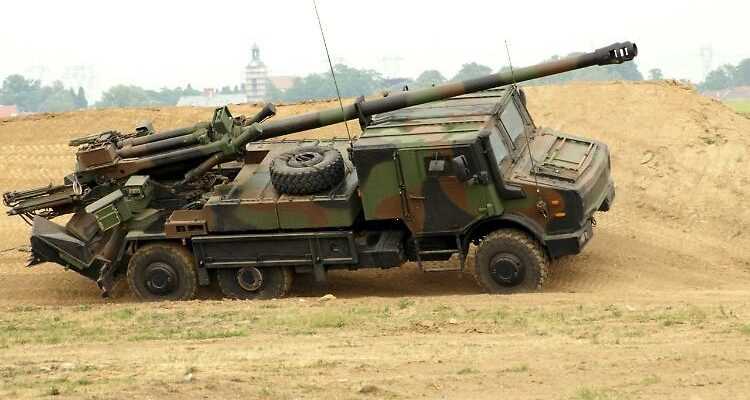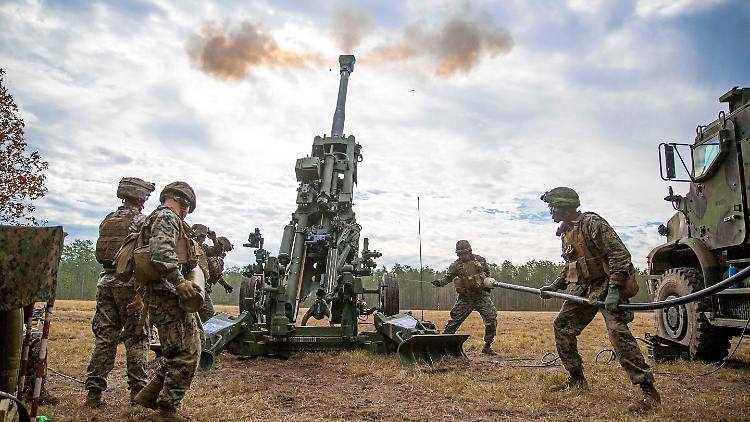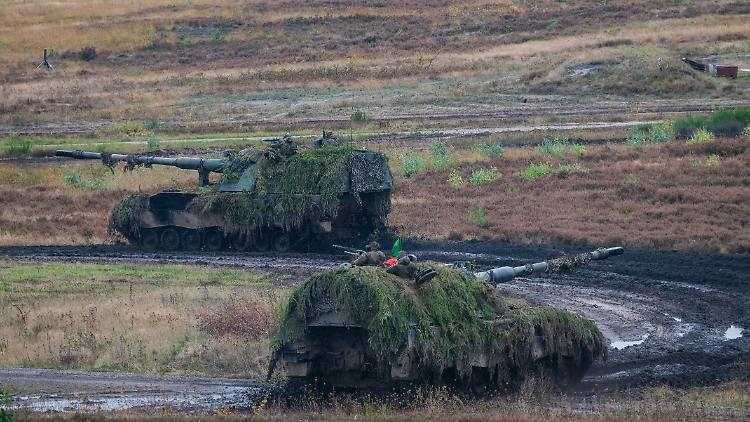For a powerful artillery
Howitzers in combat against Russia
By Holger Preiss
4/27/2022, 4:29 p.m
Several countries have announced that they intend to use howitzers to support the artillery of the Ukrainian armed forces in the fight against the Russian attacker. But what does the artillery do and what can the different howitzers do in war?
Supporting arms shipments to Ukraine continue. In addition to tanks and drones, artillery pieces in particular are intended to strengthen the armed forces in the fight against the Russian attacker. But what is the artillery for anyway, what kind of weapons are they and what can they do?
In principle, artillery is there to engage enemy ground targets, for example with large-caliber guns from a distance. It is therefore an indirect fire, which above all minimizes the opponent’s mobility. Another goal of artillery is to support and protect your own combat units by preventing the enemy from advancing through fire. It is also important to combat command, communication and reconnaissance objectives, the destruction of which can severely disrupt the enemy’s command and information structures for the moment.
In order not to become the target of the so-called “counter battery fire” yourself, it is extremely important in the combat operations, which are carried out very quickly today, to change position immediately after the shot has been fired. All of this should then also be possible with the weapon systems delivered to Ukraine.
Caesar type howitzer
For example, France has announced that it will make the system available to Caesar. The abbreviation stands for “Camion équipé d’un système d’artillerie”, which in direct translation means something like “truck equipped with an artillery system”. Specifically, Caesar is an unarmored howitzer manufactured in France with a caliber of 155 millimeters, which is built on a Unimog U 2450 6×6 in the export version from Nexter and Lohr Industrie. The French armed forces use the Renault Sherpa 5 or Sherpa 10 as a base.
The vehicles themselves are unarmoured, only protected against light splinters. The advantage of Caesar is the quick assembly and disassembly of the gun, which is measured in just under a minute. There are 18 floors on board the vehicle. The Caesar 8×8 version presented in 2016 can even transport 30 shells and the howitzer is equipped with a fully automatic loading device. However, the F3 howitzer flanged onto the Tatra 815 is also a further development and, with a 52 caliber length, is significantly longer than the original. Depending on the projectile type, distances between 30 and 50 kilometers can be covered.
M-777 howitzer
The Ukrainian troops are said to have received several M-777 artillery pieces from Canada. Unlike Caesar, this is not a self-propelled but a towed howitzer, which also has a caliber of 155 millimeters. While in service with US Army forces, the M-777 is said to be in testing only in the UK. This is surprising, because the howitzer comes from British production and is manufactured there by the company BAE Land Systems.
The advantage of the M-777 is said to be that it can be used to fire GPS-guided projectiles, which greatly increase the accuracy of the hit. In tests, a scatter of only 50 meters was found over a distance of 14.5 kilometers. The shooting distance is between 24 and 40 kilometers. Since 2018, however, the USA has been working on extending the range with appropriate ammunition. The aim is 70 kilometers. In test shooting at the Yuma Proving Ground, distances of up to 40 miles have probably already been achieved.
Howitzer 2000
The Panzerhaubitze 2000 is to be delivered to Ukraine from the Netherlands. It is not known how many, but they are definitely confirmed. It is manufactured by the German companies Krauss-Maffei Wegmann and Rheinmetall. It is also the standard gun of the Bundeswehr. This is also a 155 millimeter barrel weapon system, which is, however, moved with an armored tracked vehicle.
According to the Bundeswehr, the Panzerhaubitze 2000 is one of the most modern artillery pieces in the world. Their strength lies above all in their precision and the large combat distance. Shooting distances of 30 kilometers are achieved with the standard ammunition. With range-enhanced ammunition it is even 40 kilometers. Six grenades can be fired in such a way that they hit the target at the same time. It is also possible to fire ammunition with so-called timeable fuses, i.e. projectiles that only detonate on impact or over the target.
Another advantage of the Panzerhaubitze 2000 is the armored vehicle it carries, which has a range of 420 kilometers and a top speed of 60 km/h on the road and 45 km/h off-road, which roughly corresponds to the mobility of a main battle tank. Here, too, the location can be changed quickly after the launch to protect against possible counter-battery fire. Thanks to the tank-like substructure, the Panzerhaubitze 2000 can also be used in difficult terrain. In addition, it is able to cross waters up to a depth of 1.1 meters without preparation. With the diving hydraulics switched on, it should even be 1.5 meters.


